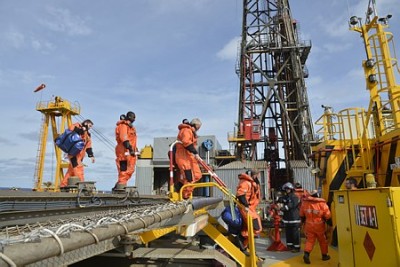High costs at Norwegian state oil company Statoil and the prospect of falling oil prices have already prompted Statoil executives to cut jobs. As the company’s share price fell again this week, analysts were also calling for Statoil to be split up.

Statoil’s shares tumbled on Wednesday, just days before Statoil officials would be facing analysts and investors at its Capital Markets Update in London on Friday, when the company will also be releasing its latest financial results.
Newspaper Dagens Næringsliv (DN) reports that some analysts now think the best way for the company to realize better value and higher returns for investors is to divide up the company into separate stocklisted entities. Calls are also rising for less state ownership in Statoil in favour of more private shareholders.
“The simplest model is to split up the international and Norwegian operations, where the Norwegian portion alone may be able to achieve a higher share price than today’s integrated company,” Trond Omdal, an analyst at Arctic Securities, told DN. “The Norwegian portion could in turn also be split up, with one division for small oil fields that also could contribute to increased competition.”

Statoil launched a major international expansion drive several years ago to diversify its operations and lessen reliance on those off the coast of Norway, largely because of fears the gas and oil were running out in the North Sea. There’s also been a major push in the Arctic, where new sources of oil and gas are believed to exist but where exploration and eventual production costs are high.
Now many analysts think Statoil would be better off concentrating on its backyard after all. Chief analyst Anne Gjøen at Handeslbanken Markets thinks Statoil has too many operations in too many countries where returns are poor.
“The profitability is in Norway and maybe a few other countries outside Norway, otherwise there’s negative cash flow,” Gjøen told DN. “We must get some debate going over a restructuring of Statoil, and spinning off various operations. Is it really so interesting for the Norwegian state to be so heavily involved in a company where the value is being pulled down by too much foreign activity?”

Statoil has grabbed headlines over the past few years for some impressive, often surprising, oil discoveries, not least those in mature areas of its own Norwegian Continental Shelf where production can be less costly than in new areas because of existing infrastructure. Statoil itself proudly notes on its on website that the company found more oil and gas last year than any other company.
But oil analysts continue to predict that oil and gas prices will fall from their record-high levels of more than USD 100 a barrel in recent years. Torbjørn Kjus, an oil analyst at Norway’s largest bank, DNB, thinks demand for oil will decline, while new sources of gas already have disrupted markets and prompted oil companies to put once-attractive prospects in the Arctic, for example, on the back-burner.
DNB Markets has predicted 2014 prices of around USD 102 per barrel, way below the USD 140 levels of several years ago and the relatively more stable levels of just under USD 120 over the past 18 months. A decline in demand coupled with factors like the prospect of more oil from Iran can put further downward pressure on prices, while Statoil’s costs keep rising.
USD 100 a barrel not enough
Even though Statoil operated profitably for years when prices were a third of what they are today, DN pointed out recently that the rise in Statoil’s costs mean that USD 100 a barrel is no longer enough to sustain profit growth now. That’s why Statoil has started cutting jobs, with more than 200 cuts announced last month and more expected. On Tuesday, chief executive Helge Lund showed that he’s willing to cut high-level personnel as well, when the company announced internally that it was putting 100 business developers’ jobs on the chopping block. DN reported that these are jobs seen as highly attractive and held by well-paid employees “who fly around for meetings and to review possible purchase and expansion deals around the world.”
Statoil is so anxious to get rid of employees that it’s been offering generous early retirement and other forms of severance packages. DN reported in January that employees aged 58 to 62 can choose to retire and receive a pension amounting to 66 percent of their current pay until they reach the standard retirement age in Norway of 67. Those who go along with being “outsourced” to jobs being transferred from Statoil to its suppliers can receive up to a full year’s pay as a “transfer bonus.” Those agreeing to simply quit can receive up to two years’ worth of full salary.
It’s all aimed at reducing Statoil’s high overhead costs, but analysts clearly don’t think it’s enough. Statoil executives, expected to stress a need for highest possible returns while toning down earlier production goals, can likely expect some tough questions and propositions from their audience in London.
Reducing the state’s stake
Statoil stock closed at NOK 147.40 per share on Wednesday, down 1.1 percent on a day when stock markets around the world were sliding but also when DNB Markets shifted from a “buy” recommendation to “sell” and cut its share price expectation from NOK 150 to NOK 145. DNB’s analysts said they saw very limited prospects for production growth in 2014, and that they expect Statoil to announce reductions.
Statoil is by no means alone in the challenges it faces, with most of the world’s large oil companies like Shell, BP and Chevron announcing various reductions to cut costs. Meanwhile, Norway’s new conservative government has expressed an interest in doing what analyst Gjøen suggests, and reducing the state’s ownership in a variety of large Norwegian companies.
Labour organizations fear job losses and are already protesting, but Monica Mæland, Norway’s new government minister in charge of business and trade from the Conservative Party, told newspaper Klassekampen last weekend that the state is “too large” on the Oslo Stock Exchange. Holdings in Statoil and several other companies including Yara, Telenor, Norsk Hydro, DNB, Aker and Kværner are under review.
newsinenglish.no/Nina Berglund

